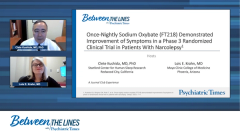
Adopting Once-Nightly Sodium Oxybate into Clinical Practice to Treat Narcolepsy
The potential benefits of integrating once-nightly sodium oxybate into routine clinical practice to help address treatment limitations for patients with narcolepsy.
Episodes in this series
Lois E. Krahn, MD: Dr Kushida, what can we learn from this paper that may impact our practice?
Clete Kushida, MD, PhD: So, this study was actually the first randomized control trial that demonstrated the efficacy and safety of a 7.5-gram dose of sodium oxybate. And given that the efficacy was nearly comparable to the 9-gram dose compared to placebo, as stated in the article, this may afford confidence for prescribers and patients that a lower dose can be effectively used in practice. Also, this, I believe is a first known publication describing a statistically significant reduction of cataplexy compared to placebo at week 1 with a 4.5-gram dose of sodium oxybate. Thirdly, clinical practice guidelines for the American Academy of Sleep Medicine set a change from baseline compared to placebo of 2 or more minutes on the maintenance of week of the test, including the 95% confidence samples as being the clinical-significant threshold. This study showed that the once-nightly sodium oxybate achieved the standard for all 3 doses evaluated, which included the 6-gram, the 7.5-gram, and the 9-gram doses.
Lois E. Krahn, MD: If I can follow up on that as a psychiatrist, we have many medications used for other conditions where we have to prepare our patients to wait a long time to have the treatment response. And all of us are impatient. So, the data that suggests and indicates that cataplexy can improve after 1 week, I think will be very well received by our patients. Many of whom can be embarrassed or maybe even put at risk if their cataplexy continues. And if this medication can help them faster, I think that that is a very important finding.
Transcript edited for clarity.
Newsletter
Receive trusted psychiatric news, expert analysis, and clinical insights — subscribe today to support your practice and your patients.













